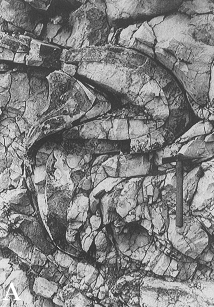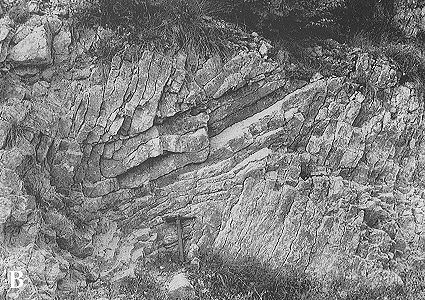

Sedimentary and tectonic folding compared
Plate 135


Sedimentary and tectonic folding compared
Plate 135
Plate 135 A shows beds of limestone and chert (darker) folded in the shape of a question mark. The outcrop occurs in a slumped mass within a carbonate; formation of Mesozoic age in southern Alps. In 135 B, beds of a lithologically similar unit are deformed into zig-zag or chevron folding, a typical tectonic structure due to compression.
Notice the differences in the geometry of folds: in A, hinges are rounded and disharmonic (with different radii of curvature), most beds being thicker there than on the flanks or limbs of the folds. In B, fold hinges are pointed, the folding more regular (repetition of the same basic unit) and harmonic (the beds keep their thickness throughout the fold profile). Furthermore, jointing is perpendicular to individual beds in A, thus showing all possible orientations, whereas it cuts through beds and is parallel to one flank of the fold in B. All these features indicate that the beds in B were deformed in more confined conditions and by a stronger, oriented stress of tectonic origin. In sliding and slumping, the deformation has more degrees of freedom.
The presence of chert in limestones deserves an annotation. Chert is crystalline silica (SiO2) and is found in primary or secondary (diagenetic) beds. Silica occurs in the hard parts of small planktonic organisms (radiolaria, diatoms), in sponge spicules, etc. Siliceous remains form distinct beds or are components of carbonate oozes. Silica is highly mobile because of its solubility in seawater and tends to replace carbonate particles. The substitution is reciprocal: the tests of silica-secreting organisms are carbonatized. One can thus ascertain the migration of silica and its secondary deposition. The chert beds shown in this plate are indeed diagenetic. If they were already been present when sliding occurred, they would have been in a gel-like or plastic state. Lithified chert is crystalline and hard; it would not fold but break.
Alternatively, silica migration might have occurred after sliding, the sliding itself providing routes for it (joints and fractures). Late diagenesis, in fact, cannot use sediment pores; deep burial and compaction, or cementation, have eliminated them. Permeability, necessary for the circulation of chemical solutions and reactions, can only be created by fracturing.
Pore reduction with depth, and a consequent increase in packing and density of sediments, has an important bearing on sliding, too, because it increases internal friction and hence shear strength and stability. Sliding is thus a relatively shallow phenomenon if referred to burial (not water) depth.
| Photos: from A. Castellarin 1964, Geologia della zona di Tremosine e Tignale (Lago di Garda). Giornale di Geologia (Bologna), 32: 291-346. |